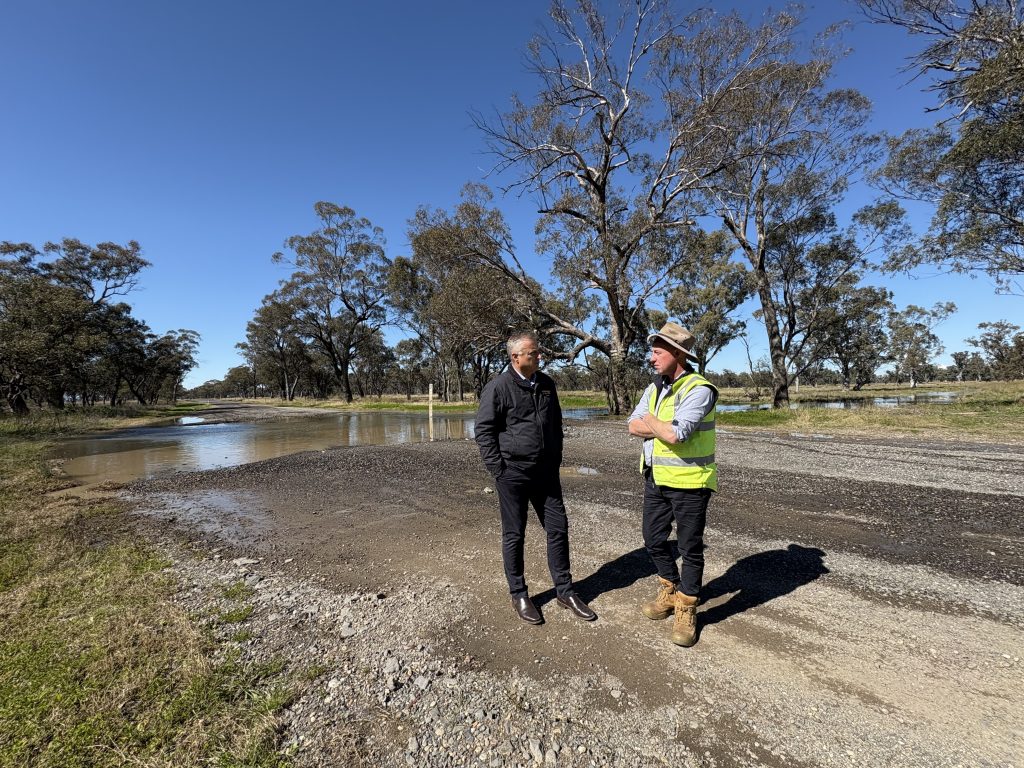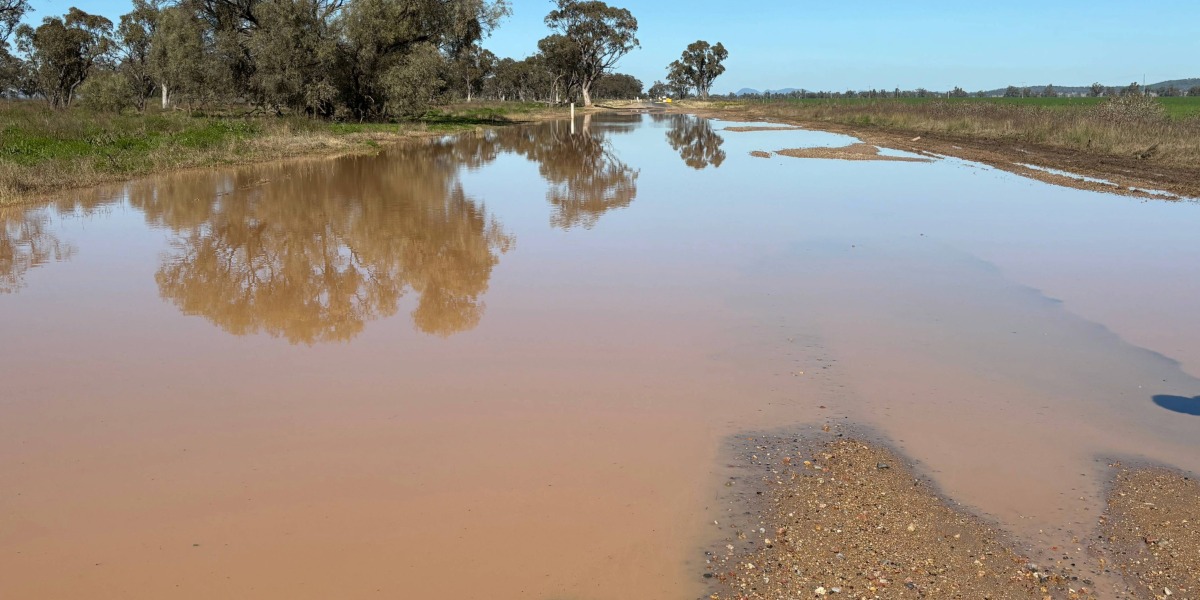As locals recover from another major flood this month, Gunnedah and Narrabri Shire Councils are among councils still waiting for approval to undertake road repairs from floods that occurred more than three years ago.
Federal Member for Parkes Jamie Chaffey inspected road damage at Grain Valley Road in Gunnedah Shire and Rangari Road in Narrabri Shire yesterday. Natural disaster declarations were made for both shires on Friday after they were inundated by floodwater early this month. The flood event has caused more damage to roads already impacted by seven major flood events between November 2021 and October 2022.
Mr Chaffey said he had heard repeated accounts of huge delays in road funding approvals, with more than $4 million in repairs still awaiting funding approval in Gunnedah Shire following floods in 2022.
“The NSW Government has left councils with nowhere to turn for funding certainty,” he said.
“Councils have sought and been given advice, have acted on this advice and then found out that it was incorrect. This costs them money and leads to massive delays in repairing roads.
“Then, after waiting two years for funding approval in some cases, they are given a revised funding figure by the NSW Government. They get the work done, only to have yet another review that again revises the funding downwards,” he said.
“The job has been done, the money has been spent, and the council and the ratepayer must now foot the bill, despite every effort of the council to do the right thing.”
Chaffey was particularly critical of the NSW Government’s policy of funding only like-for-like repairs to roads. This means roads can only be repaired to the standard they were before flooding.
“It doesn’t provide for flood-proofing and it means that every flood is groundhog day for councils and community. The same roads again need the same repairs.”
“No wonder councils absolutely despair when they are faced with another natural disaster,” he said.
“They have lost trust in the advice they are given and are facing reviews that come back with less and less funding to get the job done.”
“I am advised there is significant federal funding available for natural disaster recovery, but it appears the New South Wales Government is the blockage. It must be incredibly disappointing for councils trying to get their shires back to business following a natural disaster.”
Gunnedah Shire Mayor Colleen Fuller said council felt like there were barriers at every level to securing the promised funds.
“Frustratingly for council and incredulously for the community, we are still awaiting approval to undertake almost half of the TULG (Total Upper Limit Grant) works of $10.1 million,” Cr Fuller said.
“We have had significant delays in being able to undertake repair works, receiving payment for the work that has been completed and in receiving reliable and consistent guidance on claims.”
“We have had to look at engaging contractors to complete work after the NSW Government challenged Council’s estimates to do the work itself. All of this costs more money,” she said.
“As an example, Grain Valley Road was recently federally funded to be upgraded to a sealed road. Council has repeatedly been hit with the costs of repairing this road and is now being told to apply a road treatment that will limit the life of the road.”
Narrabri Shire Deputy Mayor Brett Dickinson said like-for-like replacement was not the answer.
“Here at Narrabri Shire Council, we are strong believers in ‘building back better’, but that is only possible with timely and well-targeted support,” Cr Dickinson said.
“Betterment is talked about at all levels of government, and with good reason; it is about making smart, lasting repairs that prevent the same flood damage from happening time and time again.”
“By investing in stronger, more resilient roads now, we can stop waste, save taxpayer dollars, and deliver a better future for our community. Rangari Road is just one example of a high-traffic route that would benefit from this approach.”

“With a road network of more than 2,000km, ratepayer contributions can only go so far, particularly after the number of flood events we have faced in recent years,” he said.
“We welcome any refinement to the Disaster Recovery Funding Arrangements guidelines, and we look forward to continuing our positive working relationship with Transport for NSW and, from October, the NSW Reconstruction Authority in delivering betterment outcomes for our region.”
Mr Chaffey said he will continue to seek the support of the Federal Minister for Emergency Management to ensure councils get the funding they need to complete road repair works in an appropriate manner, and the cost does not fall to the ratepayers.
“Councils deserve a helping hand, not a roadblock at every turn,” he said.
The calls to end the flawed disaster recovery policy approaches that shift the cost of disaster repairs on to ratepayers comes as the Minister for Recovery Janelle Saffin launched new disaster adaptation planning guidelines to establish a consistent and streamlined approach to reducing disaster risk across the State, with the expressed goal of a more consistent state-wide approach to build safer and more resilient communities.
“Hundreds of thousands of residents live in high-risk areas across our state,” Saffin said.
“This is why we are undertaking this vital work in developing regional DAPs, so communities are better prepared to respond to and recover from disasters.”
Disaster Adaptation Plans (DAPs) were a key recommendation of the 2022 Independent Flood Inquiry, which called for effective and cross-government engagement to adapt to disaster risk across the state, and through better planing and risk mitigation, reduce the rapidly escalating cost of disaster recovery.
“We’re shifting the dial on how we prepare for and deal with disasters by working together with local government and community to identify a pathway for adaptation actions and resilience across the state,” she said.
“We are empowering communities and organisations to adapt for future disasters and recover from them faster.”
Read all the way through to the end of the story? So did lots of other people. Advertise with New England Times to reach New England locals who are interested and engaged. Find out more here.

